52 Perspectives on the Korean War by Kimberly Eastham
1. Perspectives comparison: North and South Korea
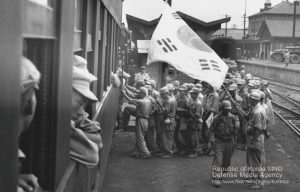
| Curriculum context | VCE Modern History, Unit 2: The Changing World Order, Area of Study 1: Causes, course and consequences of the Cold War (VCAA, 2020) |
| Historical context | Proxy wars and conflicts that reflected the consequences of tensions and divisions of the Cold War, focusing on The Korean War: the causes and consequences of the conflict, reasons for international involvement and the impact on people, countries and the Cold War superpowers (VCAA, 2022:24) |
| Historical thinking concepts | Explore historical perspectives
Use sources as evidence |
| Learning intentions | To compare and contrast the differing views of North and South Korea during the Korean War.
|
Activity
1. First, divide the class in two and assign one half to North Korea and the other half to South Korea.
2. In order to conduct thorough research, you will have the opportunity to work collaboratively in groups. This research will focus on exploring and analysing the various viewpoints about the country assigned to your group during the Korean War. * It is important for you to keep a record of your sources so that you can refer back to them during presentations.
a) Each group is encouraged to research the viewpoints of the country they have been assigned in order to understand their perspectives on:
i. the causes of the war
ii. reasons for their involvement and international involvement
iii. the impact of the war on their nation (socially and economically) and consider their perspectives on how it should be resolved.
Sources
To aid you in this endeavour, the following sources have been provided for your use.
Korean War, 1950-1953 | Wilson Center Digital Archive (Korean War, 1950-1953 | Wilson Center Digital Archive 2023)
Korean War Legacy – Korean War History Chapters (Korean War Legacy – Korean War History Chapters 2023)
The Korean War: 10 Key Events In The Story Of A Divided Korea. The Origins Of Present-Day Tension. (Segal 2022)
Korean War Legacy – Multiple Perspectives on the Korean War (Korean War Legacy – Multiple Perspectives on the Korean War 2023)
The Korean War 101: Causes, Course, and Conclusion of the Conflict (Matray 2012)
Uncovering the Hidden History of the Korean War (Miller 2020)
3. Next, analyse the findings from your research together with your group and provide a summary of the key aspects from the perspective of the assigned country.
a) consider factors such as the underlying causes of the war
b) public reactions to the involvement of the international community
c) the impact of the war on their society, economy, and political structures
d) potential threats or benefits perceived,
e) the enduring impacts of this conflict on your nation
4. As a group, you will work together on producing a presentation that provides a concise overview of your findings.
a) The presentation should have a duration of seven to ten minutes.
b) During the presentation, it is important to explore the reasons behind your country’s participation in the conflict as well as their goals and reactions to the conflict’s resolution.
c) Using visual aids like maps, political cartoons, photographs, or propaganda posters is permitted to enhance your presentations.
d) Additionally, ensure that proper citations are provided for all sources utilised.
* Presentations can be in PowerPoint, Canva or other suitable presentation platforms.
5. Please select two students from your group who would be willing to be the presenters for your presentation.
6. After the presentations, a class discussion will take place where we can delve into comparing and contrasting the two points of view. It is encouraged to ask questions regarding various matters, for instance:
i. How did each country assess the threat posed by the other?
ii. Alternatively, you could inquire about their individual objectives once the Korean War came to an end.
iii. What may have caused the different viewpoints between the two countries regarding these particular events?
iv. How did each country’s perspective impact their actions throughout the war?
v. Consider the enduring influence of these contrasting viewpoints on current inter-Korean relations.
vi. Deliberate upon both the advantages and obstacles encountered while using primary and secondary sources in historical investigation.
References
Korean War Legacy. (2023). Korean War History Chapters, Korean War Veterans Digital Memorial. https://koreanwarlegacy.org/chapters
Korean War Legacy (2023). Multiple Perspectives on the Korean War, Korean War Veterans Digital Memorial. https://koreanwarlegacy.org/chapters/multiple-perspectives-on-the-korean-war
Wilson Center Digital Archive (2023). Korean War, 1950-1953, Wilson Center. https://digitalarchive.wilsoncenter.org/topics/korean-war-1950-1953
Matray, J.I.(2012). ‘The Korean War 101: Causes, Course, and Conclusion of the Conflict, Education About Asia: US, Asia, and the World: 1914–2012, 17:3. https://www.asianstudies.org/publications/eaa/archives/the-korean-war-101-causes-course-and-conclusion-of-the-conflict
Miller, O. (2020). Uncovering the Hidden History of the Korean War’. https://thewire.in/history/uncovering-the-hidden-history-of-the-korean-war
Segal, R. (2022). The Korean war: 10 Key Events In The Story Of A Divided Korea. The Origins Of Present-Day Tension. The Perspective. https://www.theperspective.com/subjective-timeline/politics/the-korean-war
VCAA. (2020). VCE Study Design: History 2022-2026. Victorian Curriculum And Assessment Authority. https://www.vcaa.vic.edu.au/curriculum/vce/vce-study-designs/history/Pages/index.aspx
2: Civilian perspectives

| Curriculum context | Modern History, Unit 2: The Changing World Order, Area of Study 1: Causes, course and consequences of the Cold War (VCAA, 2020) |
| Historical context | Proxy wars and conflicts that reflected the consequences of tensions and divisions of the Cold War, focusing on The Korean War: the causes and consequences of the conflict, reasons for international involvement and the impact on people, countries and the Cold War superpowers (VCAA, 2020, p.24) |
| Historical thinking concepts | Explore historical perspectives
Use sources as evidence |
| Learning intention | To employ empathy and gain a thorough understanding of the Korean War through the perspectives and the experiences of Korean civilians.
|
Activity
In this activity you will conduct some research on the civilian experiences during the Korean War. It is crucial to bear in mind that civilians encompassed a diverse range of individuals, and their experiences were influenced by factors such as age, gender, geographical location, and socioeconomic status. For this activity, you will be using the information gained from the previous activity, the research and discussion conducted at the beginning of this activity as well as the provided photographs to assist in your creative piece.
1. Use the following historical sources as prompts for you beginning your research:
Korean war orphans, 1950 Republic of Korea National Archives, Public Domain
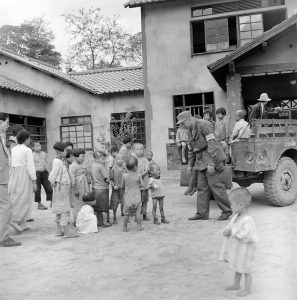
Korean War refugee with baby, Maj. R.V. Spencer, UAF (Navy). U.S. Army Korea – Installation Management Command, Public Domain
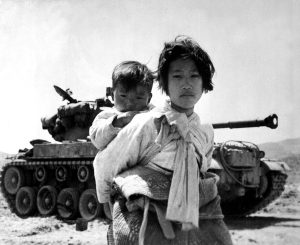
Refugees crossing Taedong River 1950-12-03, US Army, Public Domain
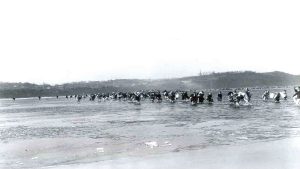
Civilians recovering building materials from the ruins in Seoul, 1950 Korean National Archives and Records, 대한민국 국가기록원 관리번호 DTC0000011, Public Domain
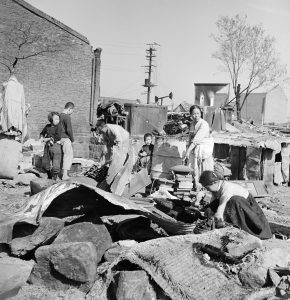
Two North Korean nurses caught by U.S soldiers, Unknown author, Public Domain

2. After completing your research, the class will come together to brainstorm and capture the different experiences that civilians went through during the conflict based on what you have collected and looking at the photographs provided. To keep track of everyone’s ideas. You can record them on a shared digital document. This brainstorming session will serve as a starting point for the next phase of the activity by incorporating real experiences and challenges encountered during the Korean War.
i) address various issues like the anxiety and unpredictability of living in a war zone
ii) the consequences of being forced to move
iii) the breaking apart of family connections and
iv) the long-term impacts of the war.
4) Based on the information you have gathered, imagine a civilian character (imagined historical actor) residing in either North or South Korea during the conflict. .Write a short narrative about their experiences. Consider aspects such as their age, occupation, family situation, and location when writing about them. The purpose of these writings is to explore the characters’ experiences, emotions, challenges, and hopes during a specific event or period in the war. Do not forget to utilise your research and brainstorming process. After finishing your narratives, please kindly submit them to a class blog or digital portfolio.
5) To wrap up the activity, it is important to have a class reflection session. You will discuss what you have learned about the civilian experience during the Korean War and consider how it might have altered your viewpoints on the conflict. Consider questions such as:
i) In what ways has this activity impacted your understanding of the Korean War?
ii) What emotions or experiences did you find were commonly shared in the narratives?
iii) How has this creative writing activity promoted historical empathy?
References
VCAA. (2020). VCE Study Design: History 2022-2026. Victorian Curriculum And Assessment Authority. https://www.vcaa.vic.edu.au/curriculum/vce/vce-study-designs/history/Pages/index.aspx

